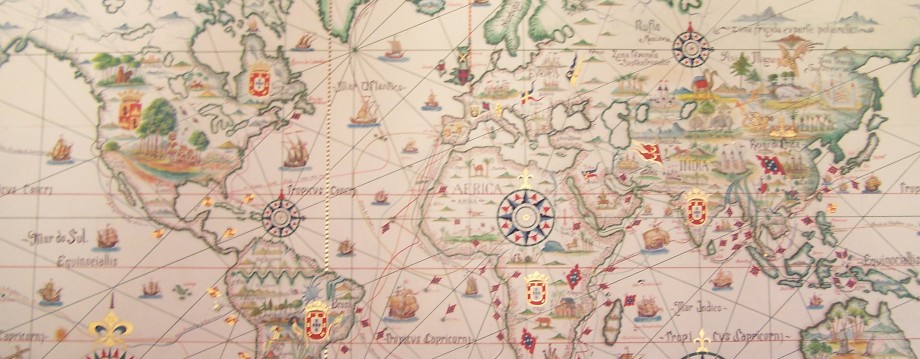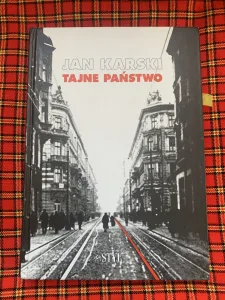As I’ve been reading off-topic recently (Arsene Wenger’s autobiography and Tolkien’s The Fall of Gondolin), I decided to catch up a bit with the “compulsory reading” posts. Today a short review of “Secret state” by Jan Karski (Jan Kozielewski). My copy was published in 1999 by the “Twój Styl” publishing house and it is, hard to believe, the first edition of this book in Poland. The book was first published in the US, in 1944. Polish version is 344 pages long, of which approximately 30 pages contain photographs at the end of the book. In addition to the photos, in the Annex you will find an interview with Karski and several press articles written by the courier during the war. Book is divided into 33 chapters, and the action began in September 1939 and ended in the summer of 1943, when Karski went to the USA, where, inter alia, he was received by President Roosevelt. A year later, a book written at fast pace by Karski, “Story of a Secret State”, was published in the United States.
As I mentioned above, the action of the book begins in September 1939. Our hero (second lieutenant of artillery) didn’t manage to fight too much before he was taken into Soviet captivity, after which he was handed over to the Germans as a “private”. He escaped from this captivity. The first chapters are interesting because they show a bit the reality of the Polish Campaign and the mood in the nation.
After escaping, Karski went to Warsaw, where through an acquaintance from his university days, he was drawn, without realizing it too much, into the activities of the emerging Underground. He was given a new identity, perfectly forged documents, and he waited for the first assignment he soon received, which was a trip to Poznań. The next task, in early 1940, was to go to Lwów and then to France, via Hungary. This mission was successful and Karski became the “official” courier between Warsaw and Paris. Unfortunately, in mid-1940, he was caught in Slovakia and tortured. Taken to Nowy Sącz, he was liberated by the Underground. After convalescence, he stayed in Krakow, working for the Information and Propaganda Office of the ZWZ-AK (Związek Walki Zbrojnej – Union of Armed Struggle, transformed later into Armia Krajowa, Home Army). The next few chapters are a description of the Underground and the rules of functioning of its individual units and departments.
At the end of 1942, Karski went on a mission to Great Britain and the USA to report on the situation of the Polish Underground and Polish Jews. Before leaving, however, he was smuggled into the Warsaw ghetto several times to see with his own eyes what the situation was behind the walls. His description of the conditions in the ghetto is depressing… Then he was taken to a transit camp in Izbica near Lublin (he himself was convinced that he had entered the death camp in Bełżec), which he entered wearing the uniform of a Ukrainian guard.
In November 1942, through Germany, France and Spain, Karski set off for London, where he met many politicians, Polish, English and Jewish. In mid-1943, he went to the USA to do the same, to present the truth about the Underground State and the Holocaust. Nobody wanted to believe him too much. In May 1943 (i.e. a month after the disclosure of the Katyn massacre by the Germans), premiere of the movie “Mission to Moscow” took place, directed by Michael Curtiz (the one who directed Casablanca), based on the memoirs of the former US ambassador to the USSR, Joseph E. Davies. The film presents Stalin as the saviour of mankind and is a masterpiece of propaganda. What followed was a conference in Tehran and another film “Battle of Russia”, this time by Frank Capra (the one who made “It’s a Wonderful Life”, among others). This film was part of the American series “Why We Fight” and also portrayed the USSR as a wonderful country.
Because of these events, the Polish Government-in-Exile decided to launch a propaganda counteroffensive. Karski was sent to the USA in early 1944 with the task of finding people willing to make a film showing the Polish Underground. The subject of “Polish”, however, did not find interest in Hollywood. There was, however, an opportunity to write a book. Within a few months, a book about the Secret State was written with the help of a bilingual typist assigned by the Polish Embassy in the USA. It was published in November 1944 and quickly became a bestseller, Karski travelled around the US promoting the book. Contracts were signed for the book to be published in several languages, but it was only possible to publish it in Swedish, Norwegian and French. The obstacle was, among others a conference in Yalta, after which people like Karski were seen as enemies of the communist government in Poland and Russia…
Below, a few pages from the Annex, at the end of the book.
Time for a summary, because I could write much more, getting off the topic, but I want you to reach for the book yourselves. I think this is a must-read for anyone who wants to learn something about the reality in occupied Poland. The book is easy to read (given the subject) as it is not a history book. One comparison came to my mind. If you’ve read “Stones for the Rampart” (“Kamienie na szaniec”, I think it’s only available in Polish), you probably remember that most of the people mentioned there die during the war. I had a similar impression when reading “Secret State”, Karski often writes things such as: soon after that they were arrested and I have never heard of them again, they must have been killed by the Germans. Of course, not all of them were murdered by the Germans, let’s not forget that Karski did not return to Poland, so it is obvious that he could not reach many people. The verdict is: a must-read!




Thank you for featuring this book by Karski……I will try to find it and read it….
It should be very easy to find, eBay, Amazon. I usually use Bookfinder website to find the cheapest option.